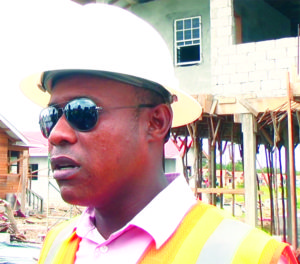…for Housing Expo

More than 400 persons are benefiting directly from the ongoing development of various housing solutions taking shape in the community of Perseverance aback Providence on the East Bank of Demerara (EBD).
Just fewer than 30 houses are being constructed in time for the model village exhibition this month-end where the public can view the new housing solutions being rolled out by the Central Housing and Planning Authority (CH&PA).
During a tour of the construction site on Monday, the Project Manager, Kennard Dazzel said these housing solutions were intended to provide start-up homes for youths, public servants and low-income earners.
“It’s not your dream home where you have a couple thousand square feet and big large acres of land. It’s just to give the beneficiaries a (start-up),” he stated.
There are 80×45 foot low-income house lots to construct 600-square foot houses; 80x62ft moderate-income house lots to construct 900-square foot houses and 80×85 ft house lots to build 1100-square foot houses.
However, Dazzel noted that extensions could be made to the houses once a certain prescribed period of time has elapsed.
Comfort, affordability
The cost of the houses will be determined by the contractors, and there will be no policy by the CH&PA to control those prices.
However, Minister within the Communities Ministry with responsibility for housing, Valerie Adams-Patterson had assured that the contractors would be penalised if they did not get the houses sold within six months; therefore, the prices would have to be competitive.
The Project Manager has guaranteed that the houses will be affordable, comfortable and of the highest quality.
“From the concrete that is coming in, we are taking the necessary slump test. We monitor in terms of the water-cement ratio, and the stuff that is coming in to pour into the concrete. We are also monitoring the steel arrangement,” he said, noting that the CH&PA was responsible for the supply of all the building materials.
He further noted that the CH&PA has learnt from the mistakes of the “1000 homes (turn-key) project”, and has put systems in place to ensure that the end product was one that not only the beneficiaries were satisfied with, but one that the agency could stand by.
In the 1000 homes project, initiated by the previous Administration, the buildings developed defects even before they were occupied.
Fireproof
The CH&PA is constructing six duplexes and two single units.
Initial reports are that the contractors will have to construct 10 low-income, five moderate-income, and eight middle-income houses.
Also on display would be two houses, constructed by a Polish company.
Dazzel explained that the latter was a result of the Minister’s visit to Poland earlier this year.
Consequent to the visit, the company shipped pre-fabricated materials to the country that would demonstrate how it constructed fireproof houses, Dazzel explained.
Fourteen contractors had signed Memorandums of Understanding (MOUs) with the CH&PA for the construction of these houses for the model village exhibition, which will be launched on April 28.
Dual payment
Interested persons would have to make two payments, one to the CH&PA for the land and another to the contractor for the house.
Purchasers would have to have an application in the authority’s system or would have to meet the criteria to qualify for an allocation.
The dual payment formula is to guarantee persons in the system are allotted homes.
Currently, there are approximately 25,000 applicants in the CH&PA system awaiting allocations. Additionally, with the minimum age being changed from 21 years to 18 years, more and more applications are being received on a daily basis.
The low-income house lots will cost G$300,000, the moderate-income G$500,000 and the middle-income G$700,000.
Future
Following the development of this model village, the CH&PA will be moving to construct duplexes and single units across the country as part of its “Housing Solution 2017 and Beyond” programme.
Some 265 buildings will be constructed this year in ten locations in six regions (Two, Three, Four, Five, Six and 10). These will be divided into 768 units, each housing a family. The units expected to cost the government about G$5 billion.



